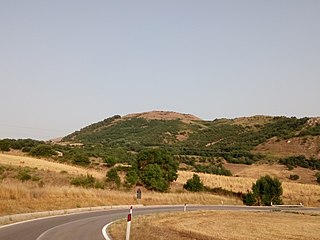Related Research Articles
Year 256 BC was a year of the pre-Julian Roman calendar. At the time it was known as the Year of the Consulship of Longus and Caedicius/Regulus. The denomination 256 BC for this year has been used since the early medieval period, when the Anno Domini calendar era became the prevalent method in Europe for naming years.
This article concerns the period 269 BC – 260 BC.
This article concerns the period 259 BC – 250 BC.
Year 260 BC was a year of the pre-Julian Roman calendar. At the time it was known as the Year of the Consulship of Asina and Duilius. The denomination 260 BC for this year has been used since the early medieval period, when the Anno Domini calendar era became the prevalent method in Europe for naming years.
Year 255 BC was a year of the pre-Julian Roman calendar. At the time it was known as the Year of the Consulship of Nobilior and Paullus. The denomination 255 BC for this year has been used since the early medieval period, when the Anno Domini calendar era became the prevalent method in Europe for naming years.
Year 251 BC was a year of the pre-Julian Roman calendar. At the time it was known as the Year of the Consulship of Metellus and Pacilus. The denomination 251 BC for this year has been used since the early medieval period, when the Anno Domini calendar era became the prevalent method in Europe for naming years.

Phalaris was the tyrant of Akragas in Sicily in Magna Graecia, from approximately 570 to 554 BC.

The Battle of Agrigentum was the first pitched battle of the First Punic War and the first large-scale military confrontation between Carthage and the Roman Republic. The battle was fought after a long siege which started in 262 BC and resulted both in a Roman victory and the beginning of Roman control of Sicily.

The Battle of the Lipari Islands or Battle of Lipara was a naval encounter fought in 260 BC during the First Punic War. A squadron of 20 Carthaginian ships commanded by Boödes surprised 17 Roman ships under the senior consul for the year Gnaeus Cornelius Scipio in Lipara Harbour. The inexperienced Romans made a poor showing, with all 17 of their ships captured, along with their commander.

The Battle of Mylae took place in 260 BC during the First Punic War and was the first real naval battle between Carthage and the Roman Republic. This battle was key in the Roman victory of Mylae as well as Sicily itself. It also marked Rome's first naval triumph and also the first use of the corvus in battle.
Hannibal Gisco was a Carthaginian military commander in charge of both land armies and naval fleets during the First Punic War against Rome. His efforts proved ultimately unsuccessful and his eventual defeat in battle led to his downfall and execution.
Gnaeus Cornelius Scipio Asina was a Roman general and statesman who fought in the First Punic War.
Aulus Atilius Caiatinus was a Roman general and statesman who achieved prominence for his military activities during the First Punic War against Carthage. As consul in 258 BC, he enjoyed several successes in Sicily, for which he later celebrated a triumph. He undertook further campaigning in Sicily both at sea and on land during a second consulship and then as dictator, becoming the first Roman dictator to lead an army outside mainland Italy.

The Via Aurelia is a Roman road in Italy constructed in approximately 241 BC. The project was undertaken by Gaius Aurelius Cotta, who at that time was censor. Cotta had a history of building roads for Rome, as he had overseen the construction of a military road in Sicily connecting Agrigentum and Panormus.
The Battle of Panormus was fought in Sicily in 250 BC during the First Punic War between a Roman army led by Lucius Caecilius Metellus and a Carthaginian force led by Hasdrubal, son of Hanno. The Roman force of two Roman and two allied legions defending the city of Panormus defeated the much larger Carthaginian army of 30,000 men and between 60 and 142 war elephants.

Sicilia was the first province acquired by the Roman Republic, encompassing the island of Sicily. The western part of the island was brought under Roman control in 241 BC at the conclusion of the First Punic War with Carthage. A praetor was regularly assigned to the island from c. 227 BC. The Kingdom of Syracuse under Hieron II remained an independent ally of Rome until its defeat in 212 BC during the Second Punic War. Thereafter the province included the whole of the island of Sicily, the island of Malta, and the smaller island groups.

Hippana or Hyppana, was an ancient town of Sicily. It sat astride the main road from Panormus to Agrigentum upon Monte dei Cavalli, in the modern comune of Prizzi. It is an important archaeological site in situated in a central position between the Tyrrhenian coast and the Mediterranean Sea, halfway between Palermo and Agrigentum.
Gaius Sulpicius Paterculus served as a consul of the Roman Republic in 258 BC, together with Aulus Atilius Calatinus. He succeeded Lucius Cornelius Scipio who was the second consul of 259.
The siege of Lilybaeum lasted for nine years, from 250 to 241 BC, as the Roman army laid siege to the Carthaginian-held Sicilian city of Lilybaeum during the First Punic War. Rome and Carthage had been at war since 264 BC, fighting mostly on the island of Sicily or in the waters around it, and the Romans were slowly pushing the Carthaginians back. By 250 BC, the Carthaginians held only the cities of Lilybaeum and Drepana; these were well-fortified and situated on the west coast, where they could be supplied and reinforced by sea without the Romans being able to use their superior army to interfere.
Publius Cornelius Scipio Asina was a Roman politician and general who served as consul in 221 BC, and as such campaigned against the Histri, a people in the northern Adriatic. Asina belonged to the Scipionic-Aemilian faction which dominated Roman politics at the beginning of the Second Punic War, and advocated for an aggressive policy against Hannibal. This stance led him to oppose the more prudent strategy of Fabius Maximus. He was notably appointed Interrex in 216 BC, probably in order to manipulate the elections.
References
- ↑ "Siege of Panormus, 254 B.C." www.historyofwar.org. Retrieved December 1, 2022.
- ↑ "Punic Wars | Summary, Causes, Battles, & Maps | Britannica". www.britannica.com. Retrieved December 1, 2022.
- ↑ "Sack of Agrigentum, 254 B.C." www.historyofwar.org. Retrieved December 1, 2022.
- ↑ "Plautus | Roman dramatist | Britannica". www.britannica.com. Retrieved December 1, 2022.